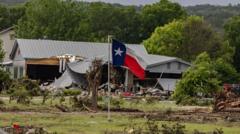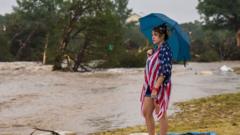While some attribute staffing reductions in meteorology to ineffective flood warnings, experts assert the forecasts were sufficient given the extreme nature of the weather event.
Did Cuts to Federal Meteorology Staff Play a Role in the Texas Flooding?

Did Cuts to Federal Meteorology Staff Play a Role in the Texas Flooding?
The tragic Texas floods have sparked debate over whether government cuts hindered effective weather forecasting.
Triggered by a devastating flooding incident in Texas, a heated discussion has ensued regarding whether federal government budget cuts to meteorological services contributed to the crisis. Several Democratic representatives highlighted concerns about the Trump administration's reductions in the National Weather Service (NWS) workforce, emphasizing the importance of accurate weather forecasts in averting disasters. Senator Chris Murphy asserted that inadequate staffing could lead to dangerous miscalculations in weather predictions.
White House Press Secretary Karoline Leavitt responded to these accusations, claiming that staffing levels remained adequate during the Texas floods. A review by BBC Verify indicated that while the NWS had indeed seen staff reductions, the number of meteorologists on duty appears to have been sufficient for issuing timely weather forecasts.
The potential cuts from the Trump administration, including a proposed 25% reduction in funding for the National Oceanic and Atmospheric Administration (NOAA), which oversees the NWS, would not take effect until October of the 2026 fiscal year. Earlier reductions that occurred earlier, including voluntary buyouts and early retirements, reduced the NWS workforce by about 600 members—which amounted to about 14% of its total staff. Reports suggest that many offices operated at reduced capacity, with vacancy rates significantly higher than in previous years.
Despite these staffing challenges, experts in meteorology argued the NWS's prediction capabilities were not impaired for the Texas floods. "The forecasts and warnings all played out in a normal manner," noted Avantika Gori from Rice University, underscoring how predicting extreme localized rainfall remains inherently difficult. Others, like Andy Hazelton, who was previously involved with NOAA, concurred that the staffing issues did not lead directly to ineffective warnings for the flooding.
Nevertheless, concerns were raised about internal communication inefficiencies among NWS local offices in Texas, particularly regarding coordination with emergency services. Some positions in critical areas, like hydrology and emergency coordination, were listed as unfilled, which may have hindered strategic communication during the crisis.
Despite these claims, the NWS had increased staffing in anticipation of severe weather events, and forecasts and alerts were issued promptly according to agency officials. While discussions recirculate about weather balloon launches—which serve a vital role in data collection—data for launch stations near the affected areas indicated that operations were continuing as scheduled, assisting in flood warnings.
As investigations unfold into the Texas flood incident, the discussions surrounding federal meteorological funding and staffing may prompt further assessments of government roles in disaster preparedness and community safety, offering a critical intersection between policy, physics, and public welfare.
White House Press Secretary Karoline Leavitt responded to these accusations, claiming that staffing levels remained adequate during the Texas floods. A review by BBC Verify indicated that while the NWS had indeed seen staff reductions, the number of meteorologists on duty appears to have been sufficient for issuing timely weather forecasts.
The potential cuts from the Trump administration, including a proposed 25% reduction in funding for the National Oceanic and Atmospheric Administration (NOAA), which oversees the NWS, would not take effect until October of the 2026 fiscal year. Earlier reductions that occurred earlier, including voluntary buyouts and early retirements, reduced the NWS workforce by about 600 members—which amounted to about 14% of its total staff. Reports suggest that many offices operated at reduced capacity, with vacancy rates significantly higher than in previous years.
Despite these staffing challenges, experts in meteorology argued the NWS's prediction capabilities were not impaired for the Texas floods. "The forecasts and warnings all played out in a normal manner," noted Avantika Gori from Rice University, underscoring how predicting extreme localized rainfall remains inherently difficult. Others, like Andy Hazelton, who was previously involved with NOAA, concurred that the staffing issues did not lead directly to ineffective warnings for the flooding.
Nevertheless, concerns were raised about internal communication inefficiencies among NWS local offices in Texas, particularly regarding coordination with emergency services. Some positions in critical areas, like hydrology and emergency coordination, were listed as unfilled, which may have hindered strategic communication during the crisis.
Despite these claims, the NWS had increased staffing in anticipation of severe weather events, and forecasts and alerts were issued promptly according to agency officials. While discussions recirculate about weather balloon launches—which serve a vital role in data collection—data for launch stations near the affected areas indicated that operations were continuing as scheduled, assisting in flood warnings.
As investigations unfold into the Texas flood incident, the discussions surrounding federal meteorological funding and staffing may prompt further assessments of government roles in disaster preparedness and community safety, offering a critical intersection between policy, physics, and public welfare.





















